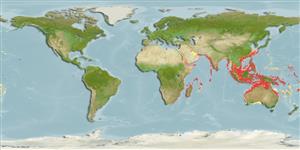Environment: milieu / climate zone / Tiefenbereich / distribution range
Ökologie
seewasser; brackwasser riff-verbunden; ozeanodrom (Ref. 51243); tiefenbereich 20 - 200 m (Ref. 28016), usually ? - 60 m (Ref. 90102). Tropical; 27°N - 37°S, 29°E - 152°E
Indo-West Pacific: Red Sea (Ref. 12541) south to the southeastern coast of South Africa and east to New Caledonia and Vanuatu. Recently reported from Tonga (Ref. 53797). Due to a widespread confusion with Sphyraena putnamae and Sphyraena qenie, the exact range is uncertain.
Size / Gewicht / Alter
Geschlechtsreife: Lm ? range ? - ? cm
Max length : 150 cm TL Männchen/unbestimmt; (Ref. 2871); common length : 120 cm TL Männchen/unbestimmt; (Ref. 5450); max. veröff. Gewicht: 11.5 kg (Ref. 40637)
Rückenflossenstacheln (insgesamt) : 6; Rückenflossenweichstrahlen (insgesamt) : 9; Afterflossenstacheln: 2; Afterflossenweichstrahlen: 7 - 9. Body with dark bars crossing lateral line, each bar oblique in upper half, but nearly vertical in lower half; caudal fin largely yellowish.
Body shape (shape guide): elongated; Cross section: oval.
Found near prominent current-swept lagoon or seaward reefs (Ref. 9710); also in bays, estuaries and turbid inner lagoons (Ref. 9768). Diurnal and solitary, although the young form schools. Feeds mainly on fishes but also takes squid. Sold fresh, frozen or dried salted. Reports of ciguatera poisoning need confirmation.
Life cycle and mating behavior
Geschlechtsreife | Fortpflanzung | Ablaichen | Eier | Fecundity | Larven
De Sylva, D.P. and F. Williams, 1986. Sphyraenidae. p. 721-726. In M.M. Smith and P.C. Heemstra (eds.) Smiths' sea fishes. Springer-Verlag, Berlin. (Ref. 5491)
IUCN Rote Liste Status (Ref. 130435: Version 2025-1)
Bedrohung für Menschen
Reports of ciguatera poisoning (Ref. 31637)
Nutzung durch Menschen
Fischereien: kommerziell; Sportfisch: ja
Tools
Zusatzinformationen
Download XML
Internet Quellen
Estimates based on models
Preferred temperature (Ref.
123201): 23.6 - 28.5, mean 27.3 °C (based on 442 cells).
Phylogenetic diversity index (Ref.
82804): PD
50 = 0.5000 [Uniqueness, from 0.5 = low to 2.0 = high].
Bayesian length-weight: a=0.00724 (0.00608 - 0.00863), b=2.92 (2.88 - 2.96), in cm total length, based on LWR estimates for this species (Ref.
93245).
Trophic level (Ref.
69278): 4.5 ±0.6 se; based on diet studies.
Generation time: 11.0 ( na - na) years. Estimated as median ln(3)/K based on 1
growth studies.
Widerstandsfähigkeit (Ref.
120179): niedrig, Verdopplung der Population dauert 4,5 - 14 Jahre. (K=0.10).
Fishing Vulnerability (Ref.
59153): Very high vulnerability (75 of 100).
🛈
Climate Vulnerability (Ref.
125649): High to very high vulnerability (73 of 100).
🛈
Nutrients (Ref.
124155): Calcium = 9.99 [4.90, 24.38] mg/100g; Iron = 0.237 [0.110, 0.480] mg/100g; Protein = 20.4 [18.5, 22.0] %; Omega3 = 0.0926 [, ] g/100g; Selenium = 48.2 [21.0, 111.8] μg/100g; VitaminA = 34.4 [8.7, 183.3] μg/100g; Zinc = 0.458 [0.304, 0.776] mg/100g (wet weight); based on
nutrient studies.
